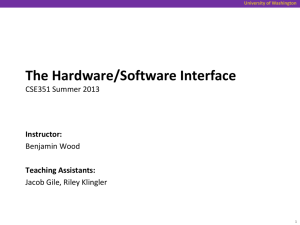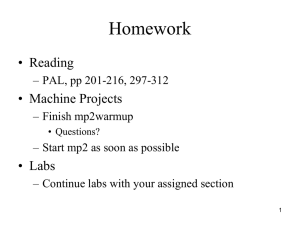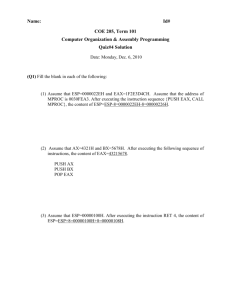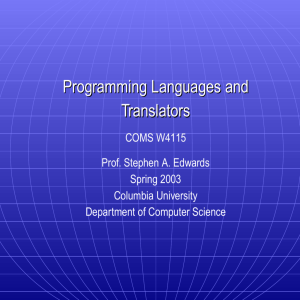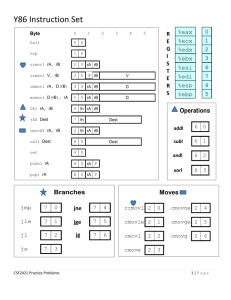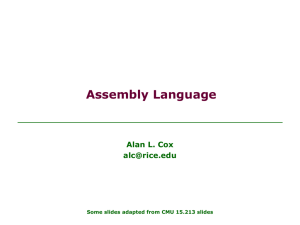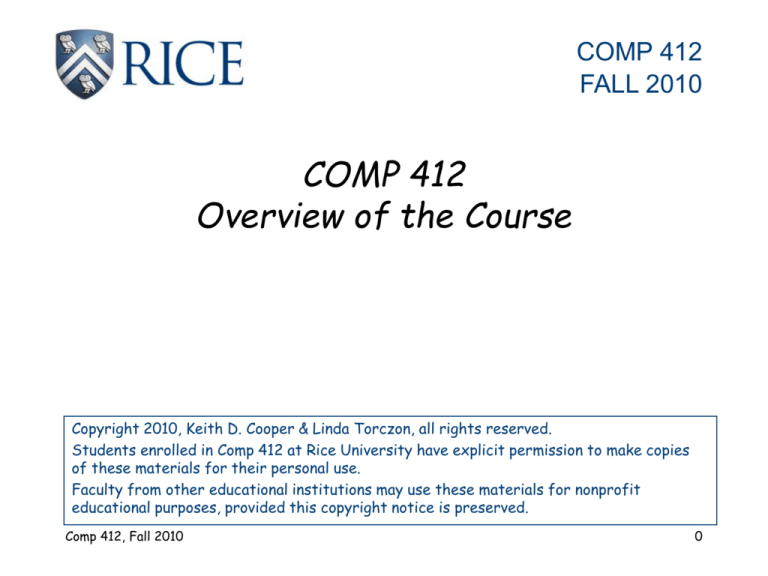
COMP 412
FALL 2010
COMP 412
Overview of the Course
Copyright 2010, Keith D. Cooper & Linda Torczon, all rights reserved.
Students enrolled in Comp 412 at Rice University have explicit permission to make copies
of these materials for their personal use.
Faculty from other educational institutions may use these materials for nonprofit
educational purposes, provided this copyright notice is preserved.
Comp 412, Fall 2010
0
Critical Facts
COMP 412 — Introduction to Compiler Construction
Topics in the design of programming language translators,
including parsing, run-time storage management, error recovery,
code generation, and optimization
Instructor:
Keith Cooper
Assistant:
Penny Anderson anderson@rice.edu
keith@rice.edu
DH 2065
x6013
DH 3080
x5186
• Office Hours: Call x6013 to see if I am around
• Text: Engineering a Compiler (Cooper and Torczon)
— Royalties for sales to COMP 412 go to the Torczon Fellowship
• Web Site: http://www.clear.rice.edu/comp412
— Lab handouts, homework, slides, practice exams, …
— I will not have handouts in class; get them from the web
Comp 412, Fall 2010 These slides are already posted. Slides should be posted before class. 1
Basis for Grading
• Exams
— Midterm
— Final
• Homework
• Projects
— Register allocator
— Parser generator
— Instruction scheduler
20%
25%
5%
This stuff will total 50% of
the course credit. If I
assign more homework than
in the past, I may shift the
percentages by up to 5%
15%
20%
15%
Notice: Any student with a disability requiring accommodations in this
class is encouraged to contact me after class or during office hours,
and to contact Rice’s Coordinator for Disabled Student Services.
Comp 412, Fall 2010
2
Basis for Grading
Exams
— Midterm
Closed-book, closed-notes exam
— Final
Questions from low attendance days
Practice exams posted on web site
Homework
Reinforce concepts & provide practice
Number of assignments will depend on
grader’s ability to return assignments
Labs
You won’t build a traditional compiler
— Register allocator
Simpler, practical labs
— Parser generator
Labs with high ratio of thought to
programming
— Instruction scheduler
Choose your language (not PERL)
Comp 412, Fall 2010
3
Rough Syllabus
•
•
•
•
•
•
•
•
•
•
•
Friday, Lab 1
Overview
§1
Local Register Allocation
§ 13.2
Scanning
§2
Parsing
§ 3 new
Context Sensitive Analysis
§4
Inner Workings of Compiled Code § 6, 7
Introduction to Optimization
§8
Code Selection
§ 11
Instruction Scheduling
§ 12
Register Allocation
§ 13
More Optimization
(time permitting)
If it looks like the
course follows the
text, that’s
because the text
was written from
the course.
What about the
missing chapters?
5 : We’ll fit it in
9, 10: see CS 512
Lab Schedule is on the web site
Comp 412, Fall 2010
4
Class-taking Technique for COMP 412
• I will use projected material extensively
— I welcome questions
— PowerPoint materials online before class
• Read the book
— Not all material will be covered in class
• Come to class
— The tests will cover both lecture and reading
— I take test questions from low-attendance classes
• Do the programming assignments
— COMP 412 is not a programming course
Projects are graded on functionality, documentation, and lab
reports, not style (results matter)
Correctness is assumed *
• Do the homework
— Good practice for the tests
Comp 412, Fall 2010
This aspect of CS 412 bothers some students. In lowerlevel programming courses, we give generous partial credit
on projects. In 412, we demand correctness. You would
never buy a compiler that did not produce correct code.
Thus, you don’t get partial credit for a lab that is written
but doesn’t compile or that produces incorrect code for
most examples.
5
Welcome to the real world.
About the Book
• Textbook: “Engineering a Compiler”
— By Keith D. Cooper and Linda M. Torczon
If you find something that looks like a typo, it may well be one
Second printing is better than first printing
• Book presents modern material
— Considers problems of post-1986 computers
— Addresses modern techniques
— Discards lots of less relevant material
• Other textbooks will be on reserve in Fondren Library
— Consult them for alternate views
We will use some material from EaC 2e.
I will provide hardcopies.
Comp 412, Fall 2010
Hand out the quiz
6
Compilers
• What is a compiler?
— A program that translates an executable program in one
language into an executable program in another language
— The compiler should improve the program, in some way
• What is an interpreter?
— A program that reads an executable program and produces the
results of executing that program
• C is typically compiled, Scheme is typically interpreted
• Java is compiled to bytecodes (code for the Java VM)
— which are then interpreted
— Or a hybrid strategy is used
Just-in-time compilation
Comp 412, Fall 2010
Common mis-statement:
X is an interpreted language
(or a compiled language)
7
Why Study Compilation?
• Compilers are important
— Responsible for many aspects of system performance
— Attaining performance has become more difficult over time
In 1980, typical code got 85% or more of peak performance
Today, that number is closer to 5 to 10% of peak
Compiler has become a prime determiner of performance
• Compilers are interesting
— Compilers include many applications of theory to practice
— Writing a compiler exposes algorithmic & engineering issues
• Compilers are everywhere
— Many practical applications have embedded languages
Commands, macros, formatting tags …
— Many applications have input formats that look like languages
Comp 412, Fall 2010
8
Reducing the Price of Abstraction
Computer Science is the art of creating virtual objects and
making them useful.
• We invent abstractions and uses for them
• We invent ways to make them efficient
• Programming is the way we realize these inventions
Well written compilers make abstraction affordable
• Cost of executing code should reflect the underlying work
rather than the way the programmer chose to write it
• Change in expression should bring small performance change
• Cannot expect compiler to devise better algorithms
— Don’t expect bubblesort to become quicksort
Comp 412, Fall 2010
9
Making Languages Usable
It was our belief that if FORTRAN, during its first months,
were to translate any reasonable “scientific” source program into
an object program only half as fast as its hand-coded
counterpart, then acceptance of our system would be in serious
danger... I believe that had we failed to produce efficient
programs, the widespread use of languages like FORTRAN would
have been seriously delayed.
— John Backus on the subject of the 1st FORTRAN compiler
Comp 412, Fall 2010
10
Simple Examples
All data collected with gcc 4.1, -O3, running on
a queiscent, multiuser Intel T9600 @ 2.8 GHz
Which is faster?
All three loops have distinct
performance.
for (i=0; i<n; i++)
for (j=0; j<n; j++)
A[i][j] = 0;
0.51 sec on 10,000 x 10,000 array
for (i=0; i<n; i++)
for (j=0; j<n; j++)
A[j][i] = 0;
1.65 sec on 10,000 x 10,000 array
p = &A[0][0];
t = n * n;
for (i=0; i<t; i++)
*p++ = 0;
0.11 sec on 10,000 x 10,000 array
A good compiler should know these tradeoffs,
on each target, and generate the best code.
Few real compilers do.
Conventional wisdom suggests using
bzero((void*) &A[0][0],(size_t) n*n*sizeof(int))
Comp 412, Fall 2010
0.52 sec on 10,000 x 10,000 array
11
Simple Examples
Example from Rn Programming
Environment, Rice, circa 1984
Abstraction has its price (& it is often higher than expected)
• In the 1980’s we built a system called the Rn Programming
Environment
— Bitmap displays and mice were new & poorly supported
— SUN Workstation (& others) had no window systems
— Predated the Mac, Windows, and so on.
• We built our own window system
— It had to represent rectangles on the screen
Rectangle was a pair of points
— Mouse tracking was difficult (10 MHz Motorola 68010)
Each mouse movement generated an interrupt
At each movement, had to repaint old mouse location, save new
mouse location, xor mouse into location, and paint result to screen
— We hit performance problems due to the point abstraction
Comp 412, Fall 2010
12
Simple Examples
Example from Rn Programming
Environment, Rice, circa 1984
This code shows the point abstraction in use
struct point {
int x; int y;
}
/* Point on the plane of windows */
void Padd(struct point p, struct point q, struct point * r)
{
r->x = p.x + q.x;
r->y = p.y + q.y;
}
int main( int argc, char *argv[] )
{
struct point p1, p2, p3;
p1.x = 1; p1.y = 1;
p2.x = 2; p2.y = 2;
Padd(p1, p2, &p3);
printf(”Result is <%d,%d>.\n”, p3.x, p3.y);
}
Comp 412, Fall 2010
13
Simple Example (point add)
_main:
L5:
gcc 4.1, -S option
(some boilerplate code ellided for brevity’s sake)
popl
movl
movl
movl
movl
leal
movl
movl
movl
movl
movl
movl
movl
movl
movl
call
movl
movl
movl
movl
leal
movl
call
addl
popl
leave
ret2010
Comp 412, Fall
%ebx
Code for Intel Core 2 Duo
$1, -16(%ebp)
$1, -12(%ebp)
$2, -24(%ebp)
Assignments to p1 and p2
$2, -20(%ebp)
-32(%ebp), %eax
%eax, 16(%esp)
-24(%ebp), %eax
-20(%ebp), %edx
%eax, 8(%esp)
%edx, 12(%esp)
Setup for call to PAdd
-16(%ebp), %eax
-12(%ebp), %edx
%eax, (%esp)
%edx, 4(%esp)
_PAdd
-28(%ebp), %eax
-32(%ebp), %edx
%eax, 8(%esp)
%edx, 4(%esp)
Setup for call
LC0-"L00000000001$pb"(%ebx), %eax
%eax, (%esp)
L_printf$stub
$68, %esp
%ebx
to printf
Address calculation for format
string in printf call
14
Simple Example (point add)
_PAdd:
pushl
movl
subl
movl
movl
addl
movl
movl
movl
movl
addl
movl
movl
leave
ret
%ebp
%esp, %ebp
$8, %esp
8(%ebp), %edx
16(%ebp), %eax
%eax, %edx
24(%ebp), %eax
%edx, (%eax)
12(%ebp), %edx
20(%ebp), %eax
%eax, %edx
24(%ebp), %eax
%edx, 4(%eax)
gcc 4.1, -S option
Code for PAdd
Actual work
The code does a lot of work to execute two add instructions.
→ Factor of 10 in overhead
→ And a window system does a lot of point adds
Code optimization (careful compile-time reasoning & transformation)
can make matters better.
Comp 412, Fall 2010
15
Simple Example (point add)
_main:
L5:
gcc 4.1, -S –O3 option
(some boilerplate code ellided for brevity’s sake)
popl
subl
movl
movl
leal
movl
call
addl
popl
leave
ret
%ebx
$20, %esp
It inlined PAdd and folded the
$3, 8(%esp)
constant values of p1 and p2.
$3, 4(%esp)
LC0-"L00000000001$pb"(%ebx), %eax
%eax, (%esp)
L_printf$stub
$20, %esp
%ebx
known
With the right information, a good compiler can work wonders.
→ It kept the body of PAdd because it could not tell if it was dead
What if it could not discern the values of p1 and p2?
Comp 412, Fall 2010
16
Simple Example (point add)
_main:
L5:
gcc 4.1, -S –O3 option
(some boilerplate code ellided for brevity’s sake)
popl
subl
movl
addl
movl
movl
leal
movl
call
addl
popl
leave
ret
%ebx
$20, %esp
_one-"L00000000001$pb"(%ebx), %eax
_two-"L00000000001$pb"(%ebx), %eax
%eax, 8(%esp)
%eax, 4(%esp)
LC0-"L00000000001$pb"(%ebx), %eax
%eax, (%esp)
L_printf$stub
$20, %esp
%ebx
I put 1 and 2 in global variables
named “one” and “two”.
The optimizer inlined PAdd
The optimizer recognized that
p1.x = p1.y and p2.x = p2.y
so
p1.x + p2.x = p1.y + p2.y.
If I make PAdd static, it
deletes the code for PAdd
This code shows the more general version. It inlined PAdd and
subjected the arguments to local optimization. It still had to
perform the adds, but it recognized that the second one was
redundant.
→ Gcc did a good job on this example.
Comp 412, Fall 2010
17
Simple Example (point add)
I lied to you
• The Rn point abstraction used short ints rather than ints
— Added conversion from short to int at call & back in Padd
— Added conversion on return value in both PAdd and caller
• A compiler cannot, in general, change the data types of
programmer-specified variables
Z80
— Original code compiled where short ≅ int
— Moved to machine where they differed
Replaced most PAdd
and PSub calls with
inline macros
— Had to rewrite the code before it could track the mouse
• Morals of the story
— A good compiler can overcome many problems
— A good compiler cannot, in general, overcome bad design
— Sometimes, you need to understand the compiler to debug code
Comp 412, Fall 2010
18
Intrinsic Merit
Compiler construction poses challenging and interesting
problems:
— Compilers must process large inputs, perform complex
algorithms, but also run quickly
— Compilers have primary responsibility for run-time performance
— Compilers are responsible for making it acceptable to use the
full power of the programming language
— Computer architects perpetually create new challenges for the
compiler by building more complex machines
Compilers must hide that complexity from the programmer
A successful compiler requires mastery of the many complex
interactions between its constituent parts
Comp 412, Fall 2010
19
Intrinsic Interest
Compiler construction involves ideas from many different
parts of computer science
Artificial intelligence
Algorithms
Theory
Systems
Architecture
Comp 412, Fall 2010
Greedy algorithms
Heuristic search techniques
Graph algorithms, union-find
Dynamic programming
DFAs & PDAs, pattern matching
Fixed-point algorithms
Allocation & naming,
Synchronization, locality
Pipeline & hierarchy management
Instruction set use
20
Why Does This Matter Today?
In the last 4 years, most processors have gone multicore
• The era of clock-speed improvements is drawing to an end
— Faster clock speeds mean higher power (n2 effect)
— Smaller wires mean higher resistance for on-chip wires
• For the near term, performance improvement will come from
placing multiple copies of the processor (core) on a single die
— Classic programs, written in old languages, are not well suited to
capitalize on this kind of multiprocessor parallelism
Parallel languages, some kinds of OO systems, functional languages
— Parallel programs require sophisticated compilers
Revenge of
COMP 210
• Think of the Intel/AMD bet on multicore as a fullemployment act for well-trained compiler writers
Comp 412, Fall 2010
21
About the Instructor
My own research program
• Compiling for advanced microprocessor systems
— Optimization for space, power, & speed
• Relationship between compiler structure & effectiveness
• Nitty-gritty things that happen in compiler back ends
• Whole program analysis & optimization
Thus, my interests lie in
• Quality of generated code
• Interplay between compiler and architecture
• Static analysis to discern program behavior
• Run-time performance analysis
Comp 412, Fall 2010
Major focus of
the PACE Project
22
Next class
• The view from 35,000 feet
— How a compiler works
— What is important
— What is hard and what is easy
• Things to do
— Read Chapter 1
— Make sure you have a working account on clear
ssh to ssh.clear.rice.edu
— Find the web site
http://www.clear.rice.edu/comp412
Comp 412, Fall 2010
23
Extra Slides Start Here
Comp 412, Fall 2010
24

